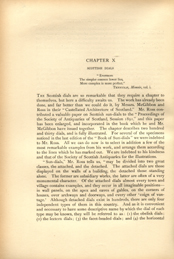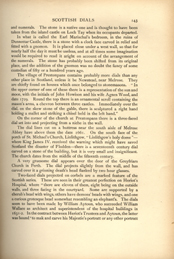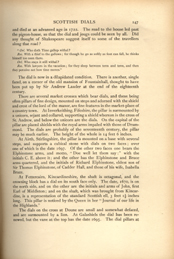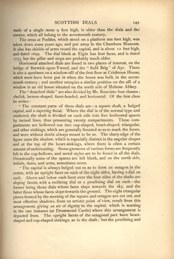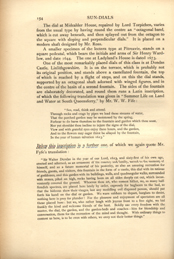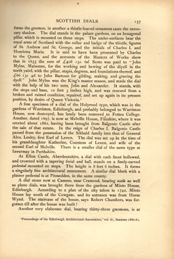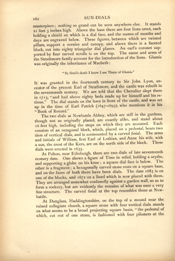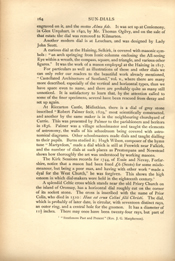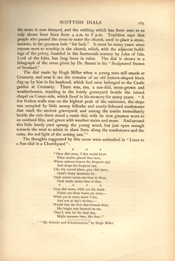CHAPTER X
SCOTTISH DIALS
|
"Evermore The simpler essence lower lies, More complex is more perfect." TENNYSON, Memoir, vol. i. |
THE Scottish dials are so remarkable that they require a chapter to themselves, but here a difficulty awaits us. The work has already been done, and far better than we could do it, by Messrs. McGibbon and Ross in their "Castellated Architecture of Scotland." Mr. Ross contributed a valuable paper on Scottish sun-dials to the "Proceedings of the Society of Antiquaries of Scotland, Session 1891," and this paper has been enlarged, and incorporated in the book which he and Mr. McGibbon have issued together. The chapter describes two hundred and thirty dials, and is fully illustrated. For several of the specimens noticed in the last edition of the "Book of Sun-dials" we were indebted to Mr. Ross. All we can do now is to select in addition a few of the most remarkable examples from his work, and arrange them according to the lines which he has marked out. We are indebted to his kindness and that of the Society of Scottish Antiquaries for the illustrations.
"Sun-dials," Mr. Ross tells us, "may be divided into two great classes, the attached, and the detached. The attached dials are those displayed on the walls of a building, the detached those standing alone. The former are subsidiary works, the latter are often of a very monumental character. Of the attached dials almost every town and village contains examples, and they occur in all imaginable positions — in wall panels, on the apex and eaves of gables, on the corners of houses, over archways and doorways, and every other 'coign of vantage.' Although detached dials exist in hundreds, there are only four independent types of them in this country. And as it is convenient and necessary to have some descriptive name by which the dial of each type may be known, they will be referred to as: (1) the obelisk dials; (2) the lectern dials; (3) the facet-headed dials; and (4) the horizontal
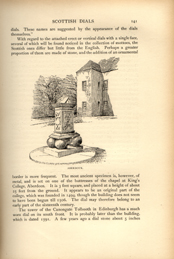
[Full Image]
ABERDOUR.
dials. These names are suggested by the appearance of the dials themselves."
With regard to the attached erect or vertical dials with a single face, several of which will be found noticed in the collection of mottoes, the Scottish ones differ but little from the English. Perhaps a greater proportion of them are made of stone, and the addition of an ornamental border is more frequent. The most ancient specimen is, however, of metal, and is set on one of the buttresses of the chapel at King's College, Aberdeen. It is 3 feet square, and placed at a height of about 25 feet from the ground. It appears to be an original part of the college, which was founded in 1494, though the building does not seem to have been begun till 1506. The dial may therefore belong to an early part of the sixteenth century.
The tower of the Canongate Tolbooth in Edinburgh has a much worn dial on its south front. It is probably later than the building, which is dated 1591. A few years ago a dial stone about 5 inches
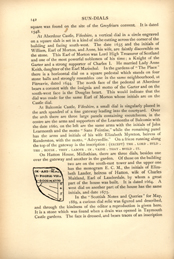
[Full Image]
[Dial stone found in Taymouth Castle Gardens].
square was found on the site of the Greyfriars convent. It is dated 1548.
At Aberdour Castle, Fifeshire, a vertical dial in a circle engraved on a square slab is set in a kind of niche cutting across the corner of the building and facing south-west. The date 1635 and the initials of William, Earl of Morton, and Anne, his wife, are faintly discernible on the stone. This Earl of Morton was Lord High Treasurer of Scotland and one of the most powerful noblemen of his time; a Knight of the Garter and a strong supporter of Charles I. He married Lady Anne Keith, daughter of the Earl Marischal. In the gardens of "The Place" there is a horizontal dial on a square pedestal which stands on four stone balls and strongly resembles one in the same neighbourhood, at Pitreavie, dated 1644. The north face of the pedestal at Aberdour bears a coronet with the insignia and motto of the Garter and on the south-west face is the Douglas heart. This would indicate that the dial was made for the same Earl of Morton whose initials are on the Castle dial.
At Balcomie Castle, Fifeshire, a small dial is singularly placed in the arch spandrel of a fine gateway leading into the courtyard. Over the arch there are three large panels containing escutcheons, in the centre are the arms and supporters of the Learmonths of Balcomie with the date 1660, on the left are the same arms with the initials of John Learmonth and the motto "Sans Feintise," while the remaining panel has the arms and initials of his wife Elizabeth Myreton, heiress of Randerston, with the motto, "Advysedlie." On a frieze running along the top of the gateway is the inscription: (EXCEPT) THE . LORD . BVLD . THE . HOUSE . THEY . LABOVR . IN . VAINE . THAT . BVILD . IT.
On Hatton House, Midlothian, there are three dials, besides one over the gateway and another in the garden. Of those on the building two are on the south-east tower and the upper one has the monogram E.C.M., the initials of Elizabeth Lauder, heiress of Hatton, wife of Charles Maitland, Earl of Lauderdale, by whom a great part of the house was built. It is dated 1664. A west dial on another part of the house has the same initials, and date 1675.
In the "Scottish Notes and Queries" for May, 1889, a curious dial relic was figured and described, and through the kindness of the editor a reproduction is given here. It is a stone which was found when a drain was opened in Taymouth Castle gardens. The face is dressed, and bears traces of an inscription
and numerals. The stone is a native one and is thought to have been taken from the island castle on Loch Tay when its occupants departed.
In what is called the Earl Marischal's bedroom, in the ruins of Dunnottar Castle, there is a stone with a clock face carved in relief and fitted with a gnomon. It is placed close under a west wall, so that for nearly half the day it must be useless, and at all times some imagination would be required to read it aright on account of the arrangement of the numerals. The stone has probably been shifted from its original place, and the addition of the gnomon was no doubt the fancy of some custodian of fifty or a hundred years ago.
The village of Prestonpans contains probably more dials than any other place in Scotland, unless it be Newstead, near Melrose. They are chiefly found on houses which once belonged to stonemasons. "In the upper corner of one of these there is a representation of the sun and moon, with the initials of John Howison and his wife Agnes Wood, and date 1729. Round the top there is an ornamental scroll containing the mason's arms, a chevron between three castles. Immediately over the dial, on the skew stone of the gable, there is sculptured a right hand holding a mallet and striking a chisel held in the left hand."
On the corner of the church at Prestonpans there is a three-faced dial set into and projecting from a niche in the wall.
The dial lines cut on a buttress near the south aisle of Melrose Abbey have above them the date 1661. On the south face of the porch of St. Michael's Church, Linlithgow, "Linlithgow's holy dome" — where King James IV. received the warning which might have saved Scotland the disaster of Flodden — there is a seventeenth century dial carved on a stone of the building, but it is very small and insignificant. The church dates from the middle of the fifteenth century.
A very gruesome dial appears over the door of the Greyfriars Church in Perth. The dial projects slightly from the wall, and has carved over it a grinning death's head flanked by two hour glasses.
Two-faced dials projected on corbels are a marked feature of the Scottish series. These are seen in their greatest perfection on Heriot's Hospital, where "there are eleven of them, eight being on the outside walls, and three facing in the courtyard. Some are supported by a cherub's head with wings, others have demons' heads with wings, and one a curious grotesque head somewhat resembling an elephant's. The dials seem to have been made by William Aytoun, who succeeded William Wallace as architect and superintendent of the hospital buildings in 1631-2. In the contract between Heriot's Trustees and Aytoun, the latter was bound to 'mak and carve his Majestie's portratt or any other portratt
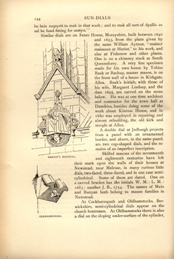
[Full Image]
HERIOT'S HOSPITAL.
OLDHAMSTOCKS.
he beis requyrit to mak in that wark; and to mak all sort of dyallis as sal be fund fitting for samyn."
Similar dials are on Innes House, Morayshire, built between 1640 and 1653, from the plans given by the same William Aytoun, "maister maissoun at Heriot," to his work, and also at Fisherow and other places. One is on a chimney stack at South Queensferry. A very fine specimen made for his own house by Tobias Baak or Bachup, master mason, is on the front wall of a house in Kirkgate, Alloa. Baak's initials, with those of his wife, Margaret Lindsay, and the date 1695, are carved on the stone below. He was at one time architect and contractor for the town hall at Dumfries, besides doing some of the work about Kinross House, and in 1680 was employed in repairing, and almost rebuilding, the old kirk and steeple at Alloa.
A double dial at Jedburgh projects from a panel with an ornamented border, and above, in the same panel, are two cup-shaped dials, and the remains of an imperfect inscription.
Skilled masons of the seventeenth and eighteenth centuries have left their mark upon the walls of their houses at Newstead, near Melrose, in many curious little dials, two-faced, three-faced, and in one case semi-cylindrical. Some of them are dated. One on a carved bracket has the initials W. M. : L. M. : 1683; another J. B., 1754. The names of Mein and Bunyan both belong to mason families in Newstead.
At Cockburnspath and Oldhamstocks, Berwickshire, semi-cylindrical dials appear on the church buttresses. At Oldhamstocks there is also a dial on the sloping under-surface of the cylinder,

[Full Image]
ALLOA.
with a stone gnomon, left when the face of the stone was otherwise cut away. There is a date 1581 on another part of the church, but it is thought that the dial may belong to an even earlier period.
A curious dial of the same type is affixed to the wall of a bastion tower about 10 feet high, which forms part of the boundary of the old garden at Seton Palace. The top of the stone forms a horizontal dial.
On Auchterhouse church, Forfarshire, a semi-cylindrical and two triangular dials are sunk in a stone on the gable, which bears the date 1630.
There are several examples of terminal dials, placed on the apex or on the lower end of the gable. Corstorphine Church (near Edinburgh) has
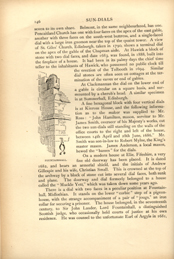
[Full Image]
FOUNTAINHALL.
seven to its own share. Belmont, in the same neighbourhood, has one. Pencaitland Church has one with four faces on the apex of the east gable, another with three faces on the south-west buttress, and a single-faced dial with a large iron gnomon near the top of the quaint tower. A view of St. Giles' Church, Edinburgh, taken in 1790, shows a terminal dial on the apex of the gable of the Chapman aisle. At Hawick a block of stone with two dial faces, and date 1683, was found, in 1888, built into the fireplace of a house. It had been in its palmy days the chief time teller to the inhabitants of Hawick, who possessed no public clock till the erection of the Tolbooth in 1694. Similar dial stones are often seen on cottages at the termination of the eaves or end of gables.
At Clackmannan the dial on the lower end of a gable is circular on a square basis, and surmounted by a cherub's head. A similar specimen is at Summerhall, Edinburgh.
A fine hexagonal block with four vertical dials is at Kinross House, and the following information as to the maker was supplied to Mr. Ross: "John Hamilton, mason, servitor to Mr. James Smith, overseer of his Majesty's works, cut the two sun-dials still standing on the walls of the office courts to the right and left of the house, between 14th April and 28th June, 1686." Mr. Smith was son-in-law to Robert Mylne, the King's master mason. James Anderson, a local mason, hewed the "basses" for the dials.
On a modern house at Elie, Fifeshire, a very fine old doorway has been placed. It is dated 1682, and bears an armorial shield, and the initials of Andrew Gillespie and his wife, Christian Small. This is crowned at the top of the archway by a block of stone cut into several dial faces, both sunk and plane. The doorway and dial formerly belonged to a house called the "Muckle Yett," which was taken down some years ago.
There is a dial with two faces in a peculiar position at Fountainhall, Midlothian. It stands on the lower "corbie" step of a pigeon-house, with the strange accompaniment of a pair of "jougs," an iron collar for securing a prisoner. The house belonged, in the seventeenth century, to Sir John Lauder, Lord Fountainhall, a distinguished Scottish judge, who occasionally held courts of justice at his own residence. He was counsel to the unfortunate Earl of Argyle in 1861,
and died at an advanced age in 1722. The road to the house led past the pigeon-house, so that the dial and jougs could be seen by all. Did any thought of Shakespeare suggest itself to some of the travelers along that road?
"Orl. Who doth Time gallop withal?
Ros. With a thief to the gallows; for though he go as softly as foot can fall, he thinks himself too soon there.
Orl. Who stays it still withal?
Ros. With lawyers in the vacation; for they sleep between term and term, and then they perceive not how time moves."
The dial is now in a dilapidated condition. There is another, single faced, on a corner of the old mansion of Fountainhall, thought to have been put up by Sir Andrew Lauder at the end of the eighteenth century.
There are several market crosses which bear dials, and these being often pillars of fine design, mounted on steps and adorned with the shield and crest of the lord of the manor, are fine features in the market-place of a country town. At Inverkeithing, Fifeshire, the pillar is surmounted by a unicorn, sejant and collared, supporting a shield whereon is the cross of St Andrew, and below the unicorn are the dials. On the capital of the pillar are placed shields with the royal arms impaled with those of Drummond. The dials are probably of the seventeenth century, the pillar may be much earlier. The height of the whole is 14 feet 6 inches.
At Airth, Stirlingshire, the pillar is mounted on a base with several steps, and supports a cubical stone with dials on two faces; over one of which is the date 1697. Of the other two faces one bears the Elphinstone arms, and motto, "Doe well let them say:" with the initials C. E. above it; and the other has the Elphinstone and Bruce arms quartered, and the initials of Richard Elphinstone, eldest son of Sir Thomas Elphinstone, of Cadder Hall, and those if his wife, Isabella Bruce.
At Fettercairn, Kincardineshire, the shaft is octagonal, and the crowning block has a dial on its south face only. The date, 1670, is on the north side, and on the other are the initials and arms of John, first Earl of Middleton; and on the shaft, which was brought from Kincardine, is a representation of the standard Scottish ell, 3 feet 1 ½ inches long. This pillar is noticed by the Queen in her "Journal of our life in the Highlands."
The dials on the cross at Doune are small and somewhat defaced, and are surmounted by a lion. At Galashiels the dial has been renewed, but the vane at the top has the date 1695. The dial pillars at

[Full Image]
AIRTH.
Pencaitland and Houston are probably also seventeenth century work. The pillar at Nairn is small and plain, about 7 feet 6 inches high, and is in a bad condition.
The market cross of Lochmaben, Dumfriesshire, is surmounted by a dial having four faces, and is crowned by a stone ball. The shaft,
made of a single stone 9 feet high, is older than the dials and the cornice, which all belong to the seventeenth century.
The cross at Peebles, which stood on a platform ten feet high, was taken down some years ago, and put away in the Chambers Museum. It also has shields of arms round the capital, and is about 12 feet high, and dated 1699. The dial block at Elgin has four faces, and is dated 1733, but the pillar and steps are probably much older.
Horizontal attached dials are found in two places of interest, on the bridge of Berwick-upon-Tweed, and the "Auld Brig" of Ayr. There is also a specimen on a window-sill of the first floor at Crichtoun House, which must have been put in when the house was built, in the seventeenth century; and another occupies a similar position on the sill of a window in an old house situated on the north side of Melrose Abbey.
The "detached dials" are also divided by Mr. Ross into four classes: obelisk, lectern-shaped, facet-headed, and horizontal. Of the first class he writes:
"The constant parts of these dials are — a square shaft, a bulged capital, and a tapering finial. Where the dial is of the normal type and unaltered, the shaft is divided on each side into five horizontal spaces by incised lines, thus presenting twenty compartments. These compartments are hollowed out into cup-shaped, heart-shaped, triangular, and other sinkings, which are generally lineated so as to mark the hours, and were without doubt always meant to be so. The sharp edge of the figure casts the shadow, which is especially distinct in the angular shapes and at the top of the heart-sinkings, where there is often a certain amount of undercutting. Stone gnomons of various forms are frequently left in the cup-hollows, and metal styles are to be found in all the dials. Occasionally some of the spaces are left blank, and on the north side, initials, dates, and arms, sometimes occur.
"The capital is always bulged out so as to form an octagon in the centre, with an upright facet on each of the eight sides, having a dial on each. Above and below each facet over the four sides of the shafts are sloping facets, with a reclining dial or a proclining dial on each — the former being those dials whose faces slope towards the sky, and the latter those whose faces slope towards the ground. The eight triangular pieces formed by the meeting of the square and octagon are cut out, and most effective shadows, from an artistic point of view, result from this arrangement, giving an air of dignity to the capital, which is wanting in the one instance (at Drummond Castle) where this arrangement is departed from. The upright facets of the octagonal part have heart-shaped and cup-shaped sinkings, as in the shaft; but the proclining and
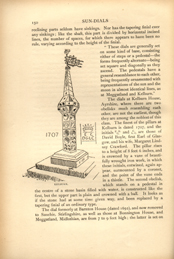
[Full Image]
KELBURN.
reclining parts seldom have sinkings. Nor has the tapering finial ever any sinkings; like the shaft, this part is divided by horizontal incised lines, the number of spaces, for which there appears to have been no rule, varying according to the height of the finial.
"These dials are generally set on some kind of base, consisting either of steps or a pedestal — the forms frequently alternate — being set square and diagonally as they ascend. The pedestals have a general resemblance to each other, being frequently ornamented with representations of the sun and the moon in almost identical lines, as at Meggatland and Kelburn."
The dials at Kelburn House, Ayrshire, where there are two obelisks much resembling each other, are not the earliest, though they are among the noblest of this class. The finest of the pillars at Kelburn is dated 1707, and the initials E.G.D. and L.C.C. are those of David Boyle, first Earl of Glasgow, and his wife, Margaret Lindsay Crawford. The pillar rises to a height of 8 feet 6 inches, and is crowned by a vane of beautiful wrought iron work, in which these initials, entwined, again appear, surmounted by a coronet, and the point of the vane ends in a thistle. The second obelisk, which stands on a pedestal in the centre of a stone basin filled with water, is constructed like the first, but the upper part is plain and crowned with a ball. It looks as if the stone had at some time given way, and been replaced by a tapering finial of an ordinary type.
The dial formerly at Barnton House (dated 1692), and now removed to Sauchie, Stirlingshire, as well as those at Bonnington House, and Meggatland, Midlothian, are from 7 to 9 feet high; the latter is set on
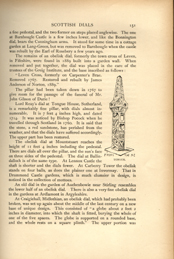
[Full Image]
TONGUE.
a fine pedestal, and the two former on steps placed anglewise. The one at Barnbougle Castle is a few inches lower, and like the Bonnington dial, bears the Cunningham arms. It stood for some time in a cottage garden at Lang-Green, but was removed to Barnbougle when the castle was rebuilt by the Earl of Rosebery a few years ago.
The remains of an obelisk dial, formerly the town cross of Leven, in Fifeshire, were found in 1889 built into a garden wall. When removed and put together, the dial was placed in the care of the trustees of the Greig Institute, and the base inscribed as follows:
"Leven Cross, formerly on Carpenter's Brae. Removed 1767. Restored and rebuilt by James Anderson of Norton, 1889."
The pillar had been taken down in 1767 to give room for the passage of the funeral of Mr. John Gibson of Durie!
Lord Reay's dial at Tongue House, Sutherland, is a remarkably fine pillar, with dials almost innumerable. It is 7 feet 4 inches high, and dated 1714. It was noticed by Bishop Pocock when he traveled through Scotland in 1760. It is said that the stone, a red sandstone, has perished from the weather, and that the dials have suffered accordingly. The upper part has been restored.
The obelisk dial at Mountstuart reaches the height of 11 feet 4 inches including the pedestal. There are dials all over the pillar, and the sun's face on three sides of the pedestal. The dial at Ballindalloch is of the same type. At Lennox Castle the shaft is shorter and the dials fewer. At Carberry Tower the obelisk stands on four balls, as does the plainer one at Invermay. That in Drummond Castle gardens, which is much clumsier in design, is noticed in the collection of mottoes.
An old dial in the garden of Auchenbowie near Stirling resembles the lower half of an obelisk dial. There is also a very fine obelisk dial in the gardens at Ardlamont in Argyleshire.
At Craigiehall, Midlothian, an obelisk dial, which had probably been broken, was set up again about the middle of the last century on a new base of unique design. This consisted of "a globe about 2 feet 2 inches in diameter, into which the shaft is fitted, burying the whole of one of the five spaces. The globe is supported on a rounded base, and the whole rests on a square plinth." The upper portion was
also renewed, but the outline is slightly curved, and there are no dials upon it.
The obelisk dial at Lochgoilhead formerly stood in what formed the marketplace, and in front of the village inn. It now stands about 20 yards away from its old position, and has been repaired and protected, but all the gnomons are gone. The stone bears the date 1626, above which is a St. Andrew's cross, the initials C.S.C., and on another stone H.D.M. The initials are thought to refer to some member of the family of Campbell of Ardkinglas.
Throughout the great sun-dial making period in Scotland, which, beginning in the sixteenth, lasted far into the eighteenth century, the making of dials of all the types already named seems to have gone on at one and the same time. The greatest number as well as the finest specimens belong to the period between 1620 and 1720. From whence came the inspiration? As regards Scottish architecture we are told 1 that the mixed style of the period between 1542 and 1700 is rather from Germany and the Low Countries than French. Our English sixteenth century detached dials are associated with such names as Kratzer, Holbein, Haveas of Cleves; but whether the art crossed the border from Scotland in the reign of James I., or whether the Scotsmen brought the first conception from Germany, and then carried it to a perfection which seems to have been attained nowhere else is a question which must, for the present, at any rate, remain undecided.
"The characteristic elements of the lectern-shaped dials," says Mr. Ross, "are a shaft (on which there are no dials) and a stone supported upon it, cut in a peculiar manner so as to contain several sun-dials, the whole having a very decided resemblance to a music stand or lectern. The dial stone is cut, angled, bevelled, and hollowed into a multiplicity of parts not easily described. In a general way the front and back present sloping surfaces, and the ends or sides are perpendicular. On the front slope there is left a square block, 3 or 4 inches thick, not unlike a closed book resting on a lectern. Suppose a square cut out of each corner of the book so as to leave the form of a Greek cross, and four semicircles cut out of the ends of the four arms of the cross, thus leaving eight horns, and you have the principal and universal feature of this kind of dial. Further, suppose the cross to be placed well up on the slope so as to project beyond it, and the projecting part containing the semi-cylinder cut out of its upper side continued down the sloping back of the dial, and you have another constant feature of this design. The forerunners
1 "McGibbon and Ross. Cast. Arch. Scot." v. ii. 13.
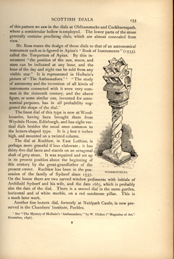
[Full Image]
WOODHOUSELEE.
of this pattern we saw in the dials at Oldhamstocks and Cockburnspath, where a semicircular hollow is employed. The lower parts of the stone generally contains proclining dials, which are almost concealed from view.'
Mr. Ross traces the design of these dials to that of an astronomical instrument such as is figured in Apian's "Book of Instruments" (1533), called the Torquetum of Apian. By this instrument "the position of the sun, moon, and stars can be indicated at any hour, and the hour of the day and night can be told from any visible star." It is represented in Holbein's picture of "the Ambassadors." 1 "The study of astronomy and the invention of all kinds of instruments connected with it were very common in the sixteenth century, and the above figure, or some similar one, invented for astronomical purposes, has in all probability suggested the shape of the dial."
The finest dial of this type is now at Woodhouselee, having been brought there from Wrychtis House, Edinburgh, and has eight vertical dials besides the usual ones common to the lectern-shaped type. It is 3 feet 6 inches high, and mounted on a twisted column.
The dial at Ruchlaw, in East Lothian, is perhaps more graceful if less elaborate; it has thirty-five dial faces and stands on an octagonal shaft of grey stone. It was repaired and set up in its present position about the beginning of this century by the great-grandfather of the present owner. Ruchlaw has been in the possession of the family of Sydserf since 1537. On the house there are two carved window pediments with initials of Archibald Sydserf and his wife, and the date 1663, which is probably also the date of the dial. There is a second dial in the same garden, horizontal and of white marble, on a red sandstone pillar. This is a much late work.
Another fine lectern dial, formerly at Neidpath Castle, is now preserved in the Chambers' Institute, Peebles.
1 See "The Mystery of Holbein's 'Ambassadors,'" by W. Dickes ("Magazine of Art," November, 1896).
The dial at Midcalder House, repaired by Lord Torpichen, varies from the usual type by having round the centre an "octagonal band, which is cut away beneath, and then splayed out from the octagon to the square with sloping and perpendicular dials." It is placed on a modern shaft designed by Mr. Ross.
A smaller specimen of the lectern type at Pitreavie, stands on a square pedestal, which bears the initials and arms of Sir Henry Wardlaw, and date 1644. The one at Ladyland's House is dated 1673.
One of the most remarkably placed dials of this class is at Dundas Castle, Linlithgowshire. It is on the terrace, which is probably not its original position, and stands above a castellated fountain, the top of which is reached by a flight of steps, and on this the dial stands, supported by an octagonal shaft adorned with winged figures, and in the centre of the basin of a second fountain. The sides of the fountain are elaborately decorated, and round them runs a Latin inscription, of which the following translation was given in "Summer Life on Land and Water at South Queensferry." by Mr. W. W. Fife:
"See, read, think and attend.
Through rocks and crags by pipes we lead these streams of water,
That the parched garden may be moistened by the spring,
Forbear to do harm therefore to the fountain and garden which thou seest,
Nor yet shouldst thou incline to injure the signs of the dial,
View and with grateful eyes enjoy these hours, and the garden,
And to the flowers may eager thirst be allayed by the fountain,
In the year of human salvation 1623."
Below this inscription is a further one, of which we again quote Mr. Fyfe's translation:
"Sir Walter Dundas in the year of our Lord, 1623, and the sixty-first of his own age, erected and adorned, as an ornament of his country and family, sacred to the memory of himself, and as a future memorial of his posterity, as also an amusing recreation for friends, guests, and visitors, this fountain in the form of a castle, this dial with its retinue of goddesses, and this garden with its buildings, walls and quadrangular walks, surrounded with stones, piled on high, rocks having been on all sides deeply cut out, which inconveniently covered the ground. Whoever thou art, who comest hither, we, so many half-fiendish specters, are placed here lately by order, expressly for bugbears to the bad, so that the hideous show their visages, lest any meddling evil disposed person, should put forth his hand on the dial or garden. We warn robbers to depart, burglars to desist, nothing here is prey for plunder! For the pleasure and enjoyment of spectators are all these placed here : but we, who rather laugh with joyous front to a free sight, we bid frankly the kind and welcome friends of the host. Boldly use every freedom with the master, the dial, the garden, and the garden-beds and couches — him for friendship and conversation, them for the recreation of the mind and thought. With ordinary things to content us here, is to be even with others, we envy not their better things."
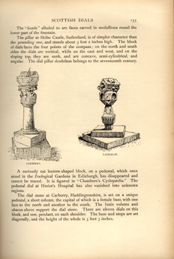
[Full Image]
CARBERRY.
LAINSHAW.
The "fiends" alluded to are faces carved in medallions round the lower part of the fountain.
The pillar at Skibo Castle, Sutherland, is of simpler character than the preceding one, and stands about 3 feet 2 inches high. The block of dials faces the four points of the compass; on the north and south sides the dials are vertical, while on the east and west, and on the sloping top, they are sunk, and are concave, semi-cylindrical, and angular. The dial pillar doubtless belongs to the seventeenth century.
A curiously cut lectern-shaped block, on a pedestal, which once stood in the Zoological Gardens in Edinburgh, has disappeared and cannot be traced. It is figured in "Chambers's Cyclopædia." The pedestal dial at Heriot's Hospital has also vanished into unknown regions.
The dial stone at Carberry, Haddingtonshire, is set on a unique pedestal, a short column, the capital of which is a female bust, with one face to the north and another to the south. The Ionic volutes and abacus above support the dial stone. There are eleven dials on this block, and one, pendant, on each shoulder. The base and steps are set diagonally, and the height of the whole is 3 feet 3 inches.
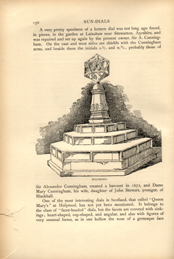
[Full Image]
HOLYROOD.
A very pretty specimen of a lectern dial was not long ago found, in pieces, in the garden at Lainshaw near Stewarton, Ayrshire, and was repaired and set up again by the present owner, Sir A. Cunningham. On the east and west sides are shields with the Cunningham arms, and beside them the initials A.SC., and M.DC., probably those of Sir Alexander Cunningham, created a baronet in 1672, and Dame Mary Cunningham, his wife, daughter of John Stewart, younger, of Blackhall.
One of the most interesting dials in Scotland, that called "Queen Mary's" at Holyrood, has not yet been mentioned. It belongs to the class of "facet-headed" dials, but the facets are covered with sinkings; heart-shaped, cup-shaped, and angular, and also with figures of very unusual forms, as in one hollow the nose of a grotesque face
forms the gnomon, in another a thistle-leaved ornament casts the necessary shadow. The dial stands in the palace gardens, on an hexagonal pillar, which is mounted on three steps. The under-surfaces bear the royal arms of Scotland with the collar and badge of the thistle, figures of St. Andrew and St. George, and the initials of Charles I. and Henrietta Maria. It is said to have been presented by Charles to the Queen, and the accounts of the Masters of Works show that in 1633 the sum of £408 15s. 6d. Scots was paid to "John Mylne, Maisonne, for the working and hewing of the diyell in the north yaird, with the pillar, stapis, degrees, and foundations thereof, and £66 13s. 4d. to John Bartoun for gilding, making, and graving the dyell." John Mylne was the King's master mason, and made the dial with the help of his two sons, John and Alexander. It stands, with the steps and base, 10 feet 3 inches high, and was rescued from a broken and ruined condition, repaired, and set up again in its present position, by desire of Queen Victoria.1
A fine specimen of a dial of the Holyrood type, which was in the gardens of Warriston, Edinburgh, and probably belonged to Warriston House, now destroyed, has lately been removed to Fettes College. Another, dated 1697, is now at Melville House, Fifeshire, where it was erected about 1862, having been brought from Balgonie Castle after the sale of that estate. In the reign of Charles I. Balgonie Castle passed from the possession of the Sibbald family into that of General Alex. Lesley, first Earl of Leven. The dial was set up in the time of his granddaughter Katherine, Countess of Leven, and wife of the second Earl of Melville. There is a smaller dial of the same type at Invermay in Perthshire.
At Ellon Castle, Aberdeenshire, a dial with each facet hollowed, and crowned with a tapering finial and ball, stands on a finely-carved pedestal mounted on steps. The height is 8 feet 6 inches. It forms a singularly fine architectural monument. A similar dial block with a plainer pedestal is at Pitmedden, in the same county.
A dial stone now at Cammo, near Cramond, bearing sunk as well as plane dials, was brought there from the gardens of Minto House, Edinburgh. According to a plan of the city taken in 1742, Minto House lay south of the Cowgate, and its entrance was from Horse Wynd. The staircase of the house, says Robert Chambers, was forgotten till after the house was built!
Another very elaborate dial, bearing thirty-three gnomons, is at
1 'Proceedings of the Edinburgh Architectural Association," vol. iii., Sessions 1880-81.
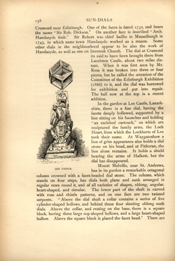
[Full Image]
LEE CASTLE.
Cramond near Edinburgh. One of the faces is dated 1732, and bears the name "Sir Rob. Dickson." On another face is inscribed "Arch. Handasyde fecit." Sir Robert was chief baillie in Musselburgh in 1745, in which same town Handasyde worked as a mason. Some other dials in the neighbourhood appear to be also the work of Handasyde, as well as one on Inveresk Church. The dial at Carmond its said to have been brought there from Lauriston Castle, about two miles distant. When it was first seen by Mr. Ross it was broken into three or four pieces, but he called the attention of the Committee of the Edinburgh Exhibition (1886) to it, and the dial was borrowed for exhibition and put into repair. The ball now at the top is a recent addition.
In the garden at Lee Castle, Lanarkshire, there is a fine dial, having the facets deeply hollowed, supported by a lion sitting on his haunches and holding "an enriched cartouch," on which are sculptured the family arms, the Lock Heart, from which the Lockharts of Lee took their name. At Waygateshaw a lion of grim appearance also holds a dial stone on his head, and at Pitferran, the lion alone remains. It holds a shield bearing the arms of Halkett, but the dial has disappeared.
Mount Melville, near St. Andrews, has in its garden a remarkable octagonal column crowned with a facet-headed dial stone. The column, which stands on four steps, has dials both plane and sunk arranged in regular rows round it, and of all varieties of shapes, oblong, angular, heart-shaped, and circular. The lower part of the shaft is carved with rose and thistle patterns, and on one face are two twisted serpents. "Above the dial shaft a collar contains a series of five cylinder-shaped hollows, and behind these four slanting oblong sunk dials. Above the collar, and resting on the base, there is a square block, having three large cup-shaped hollows, and a large heart-shaped hollow. Above the square block is placed the facet head." There are
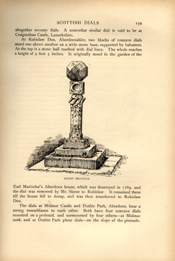
[Full Image]
MOUNT MELVILLE.
altogether seventy dials. A somewhat similar dial is said to be at Craignethan Castle, Lanarkshire.
At Rubislaw Den, Aberdeenshire, two block of concave dials stand one above another on a wide stone base, supported by balusters. At the top is a stone ball marked with dial lines. The whole reaches a height of 9 feet 5 inches. It originally stood in the garden of the Earl Marischal's Aberdeen house, which was destroyed in 1789, and the dial was removed by Mr. Skene to Rubislaw. It remained there till the house fell to decay, and was then transferred to Rubislaw Den.
The dials at Midmar Castle and Duthie Park, Aberdeen, bear a strong resemblance to each other. Both have four concave dials mounted on a pedestal, and surmounted by four others — at Midmar sunk, and at Duthie Park plane dials — on the slope of the pinnacle.
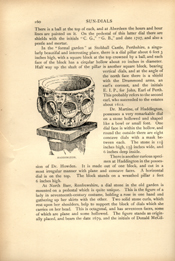
[Full Image]
HADDINGTON.
There is a ball at the top of each, and at Aberdeen the hours and hour lines are painted on it. On the pedestal of this latter dial there are shields with the initials "C. G.," "G. B.," and date 1707, and also a pestle and mortar.
In the "formal garden" at Stobhall Castle, Perthshire, a singularly beautiful and interesting place, there is a dial pillar about 6 feet 3 inches high, with a square block at the top crowned by a ball, and each face of the block has a circular hollow about 10 inches in diameter. Half way up the shaft of the pillar is another square block, bearing vertical dials, and at the angle of the north face there is a shield with the Drummond arms, an earl's coronet, and the initials E. I. P., for John, Earl of Perth. This probably refers to the second earl, who succeeded to the estates about 1612.
Dr. Martine, of Haddington, possesses a very remarkable dial on a stone hollowed and shaped like a bowl or small font. One dial face is within the hollow, and round the outside there are eight concave dials with a mask between each. The stone is 11 ½ inches high, 15 ½ inches wide, and 6 inches deep inside.
There is another curious specimen at Haddington in the possession of Dr. Howden. It is made out of one block, and cut in a most irregular manner with plane and concave faces. A horizontal dial is on the top. The block stands on a wreathed pillar 2 feet 6 inches high.
At North Barr, Renfrewshire, a dial stone in the old garden is mounted on a pedestal which is quite unique. This is the figure of a lady in seventeenth-century costume, holding a rose in one hand and gathering up her skirts with the other. Two solid stone curls, which rest upon her shoulders, help to support the block of dials which she carries on her head. This is octagonal, and has seventeen faces, some of which are plane and some hollowed. The figure stands as originally placed, and bears the date 1679, and the initials of Donald McGil-
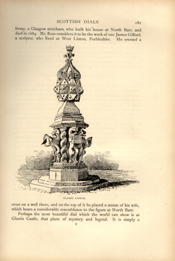
[Full Image]
GLAMIS CASTLE.
livray, a Glasgow merchant, who built his house at North Barr, and died in 1684. Mr. Ross considers it to be the work of one James Gifford, a sculptor, who lived at West Linton, Peebleshire. He erected a cross on a well there, and on top of it he placed a statue of his wife, which bears a considerable resemblance to the figure at North Barr.
Perhaps the most beautiful dial which the world can show is at Glamis Castle, that place of mystery and legend. It is simply a
masterpiece; nothing so grand can be seen anywhere else. It stands 21 feet 3 inches high. Above the base there are four lions erect, each holding a shield on which is a dial face, and the names of months and days are engraved below. These figures, between which are twisted pillars, support a cornice and canopy, and above there is a faceted block, cut into eighty triangular dial planes. An earl's coronet supported by four carved scrolls is on the top. The name and arms of the Strathmore family account for the introduction of the lions. Glamis was originally the inheritance of Macbeth:
"By Sinel's death I know I am Thane of Glamis."
It was granted in the fourteenth century to Sir John Lyon, ancestor of the present Earl of Strathmore, and the castle was rebuilt in the seventeenth century. We are told that the Chevalier slept there in 1715, "and had above eighty beds make up for himself and his retinue." The dial stands on the lawn in front of the castle, and was set up in the time of Earl Patrick (1647-1695), who mentions it in his "Book of Record."
The two dials at Newbattle Abbey, which are still in the gardens, though not as originally placed, are exactly alike, and stand about 16 feet high, including the steps on which they are mounted. Each consists of an octagonal block, which, placed on a pedestal, bears two tiers of vertical dials, and is surmounted by a carved finial. The arms and initials of William, first Earl of Lothian, and Anne his wife, with a sun, the crest of the Kers, are on the north side of the block. These dials were erected in 1635.
At Polton, near Edinburgh, there are two dials of late seventeenth century date. One shows a figure of Time in relief, holding a scythe, and supporting a globe on his knee; a square dial face is below. The other is a fragment; a hexagonally carved stone rests on a square base, and on the faces of both there have been dials. The date 1685 is on one of the blocks, and 1672 on a lintel which is now placed with them. They are arranged somewhat confusedly against a garden wall, so as to form a rockery, but are evidently the remains of what was once a very fine structure. The carved finial at the top resembles those at Newbattle.
At Dunglass, Haddingtonshire, on the top of a mound near the ruined collegiate church, a square stone with four vertical dials stands on what seems to be a broad projecting square basin, "the pedestal of which, cut out of one stone, is fashioned with four pilaster at the
angles; these are fully relieved, showing daylight between." The upper surface of the serving basin is flat.
An obelisk dial, formerly at Barnton House, has been already noticed. Another stone structure, once at the same place, but now at Sauchie, Stirlingshire, has two tiers of vertical dials mounted on a pedestal which stands on steps placed anglewise, and reaches altogether to the height of 10 feet 2 ½ inches. Lord Balmerinoch's arms are on the north face. It would seem that this dial must have been removed from the old house at Barnton, built by Lord Balmerinoch in 1623, and was probably set up by the fourth lord, who sold Barnton in 1688. His son, the last Lord Balmerinoch, took part in the rebellion of 1745, and was beheaded on Tower Hill.
The dial at Pinkie House, Midlothian, is supposed to have been put up by Alexander Seton, Earl of Dunfermline, who died there in 1622. It is a stone cube with vertical dials, crowned by a finial of the same style as those at Newbattle, and stands on a garden wall. There is also a fine specimen of a horizontal dial at Pinkie, but it is broken into two pieces. The sides are scalloped, and enclose sunk and plane vertical dials, and twisted serpents. There are vertical dials also on the house.
At Forgue, Elgin, a block of vertical dials with cherubs' heads at the top, which seems once to have been built into the corner of the wall, has now been mounted on a pedestal and fixed on the buttress of St. Margaret's Church. It has belonged for several generations to the family of the Rev. William Temple, and the names of six of his ancestors, with the dates of their death, are cut on the pedestal. The date of the dial is 1710.
At Bowland, near Galashiels, there are two solid stone posts to what was once a gateway entrance, and on the tapering top of each is a globe round which the hours are figured. The gnomon is an iron rod pointing from the north pole.
At Inch House, Midlothian, a horizontal octagonal dial is surrounded by vertical and hollow faces on the eight sides. These are supported by cherubs' heads, like those at Heriot's Hospital, which in their turn rest upon a cubical base bearing three dials and the arms of the Preston family. The whole stands on an ivy-covered pedestal.
At New Hall, Penicuik, a globe is poised on the top of a hollow cylinder, which serves as the gnomon of a horizontal dial.
In the grounds of Kilmarten, in Glen Urquhart, Inverness-shire, there is a dial 5 feet high, consisting of a square block of stone resting on four marble balls. The face is of copper, and has the Ogilvy crest
engraved on it, and the motto Alma fide. It was set up at Coniemony, in Glen Urquhart, in 1840, by Mr. Thomas Ogilvy, and on the sale of that estate the dial was removed to Kilmarten.
Another modern dial is at Leuchars, and was designed by Lady John Scott.
A curious dial at the Haining, Selkirk, is covered with masonic symbols: "an arch springing from Ionic columns enclosing the All-seeing Eye within a wreath, the compass, square, and triangle, and various other figures." It was the work of a mason employed at the Haining in 1817.
For particulars as well as illustrations of these and other dials we can only refer our readers to the beautiful work already mentioned, "Castellated Architecture of Scotland," vol. v., where there are many more described, especially of the vertical and horizontal types, than we have space even to name, and there are probably quite as many still unnoticed. It is satisfactory to learn that, by the attention called to some of the finer specimens, several have been rescued from decay and set up again.
At Riccarton Castle, Midlothian, there is a dial of grey stone inscribed "Robert Palmer fecit, 1829," most scientifically constructed, and another by the same maker is in the neighbouring churchyard of Currie. This was presented by Palmer to the parishioners and heritors in 1836. Palmer was a village schoolmaster and taught the elements of astronomy, the walls of his schoolroom being covered with astronomical diagrams. Other schoolmasters made dials and taught dialling to their pupils. Burns studied it; Hugh Wilson, composer of the hymn tune "Martyrdom," made a dial which is still at Fenwick near Falkirk, and the number of dials at such places as Prestonpans and Newstead shows how thoroughly the art was understood by working masons.
The Kirk Sessions records for 1744, of Essie and Nevay, Forfarshire, notice that a mason had been fined £6 (Scots) for some misdemeanour, but being a poor man, and having with other work "made a dyal for the West Church," he was forgiven. This shows the high esteem in which dial-makers were held in the eighteenth century. 1
A splendid Celtic cross which stands near the old Priory Church on the island of Oronsay, has a horizontal dial roughly cut on the corner of its socket stone. The cross is inscribed with the name of Prior Colin, who died in 1510; Haec est crux Colini filii Christi. The dial, which is probably of later date, is circular, with seventeen distinct rays, an outer ring, and a central hole for the gnomon. It has a diameter of 11 ½ inches. There may once have been twenty-four rays, but part of
1 "Strathmore Past and Present" (Rev. J. G. Macpherson).
the stone is now decayed, and the rubbing which has been sent to us only shows hour lines from 4 a.m. to 8 p.m. Tradition says that people who passed the cross to enter the church, used to place a stone, sunwise, in the gnomon hole "for luck." It must be many years since anyone went to worship in the church, which, with the adjacent buildings of the priory, founded in the fourteenth century by John of Isla, Lord of the Isles, has long been in ruins. The dial is shown in a lithograph of the cross given by Dr. Stuart in his "Sculptured Stones of Scotland."
The dial made by Hugh Miller when a young man still stands at Cromarty, and near it are the remains of an old lectern-shaped block dug up by him in his boyhood, which had once belonged to the Castle garden at Cromarty. There was, too, a sun-dial, moss-grown and weatherbeaten, standing in the lonely graveyard beside the ruined chapel on Conan-side, which lived in his memory for many years. "A few broken walls rose on the highest peak of the eminence, the slope was occupied by little mossy hillocks and sorely-lichened tombstones that mark the ancient graveyard, and among the tombs immediately beside the ruin there stood a rustic dial, with its iron gnomon worn to an oxidized film, and green with weather stains and moss. And around this little lonely yard sprang the young wood, but just open enough towards the west to admit in slant lines along the tombstones and the ruins, the red light of the setting sun."1
The thoughts suggested by this scene were embodied in "Lines to a Sun-dial in a Churchyard":
* * * *
"Grey dial stone, I fain would know
What motive placed thee here,
Where sadness heaves the frequent sigh
And drops the frequent tear.
Like thy carved plane, grey dial stone,
Grief's weary mourners be:
Dark sorrow metes out time to them,
Dark shade metes time to thee.* * * *
Grey dial stone, while yet thy shade
Points out those hours are mine, —
While yet at every morn I rise,
And rest at day's decline, —
Would that the SUN that formed thine,
His bright rays beamed on me,
That I, wise for the final day,
Might measure time, like thee!"
1 "My Schools and Schoolmasters," by Hugh Miller.
